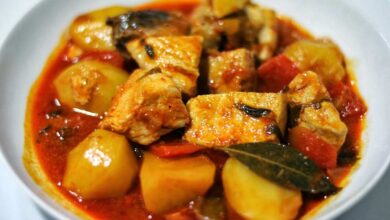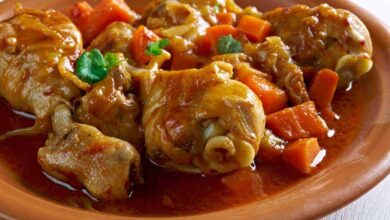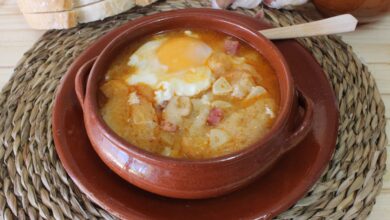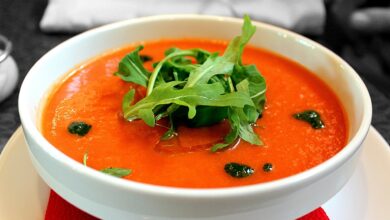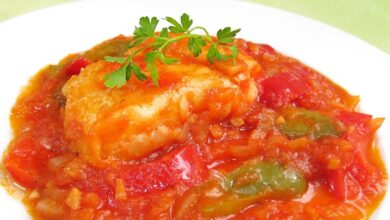Madrid-Style Stew
Today, in Spain from the Cuisine, we going to learn to elaborate the most famous stew of Spanish cousiine, the “Cocido Madrileño” or Madrid-Style Stew recipe, is a traditional stew originating from Madrid, Spain. It is believed to have originated in the Middle Ages as a one-pot meal made with chickpeas and other ingredients such as meats, vegetables, and spices. Over time, the recipe has evolved and various regional variations have developed. Today, it is a popular dish in Madrid and is typically served during colder months. The exact ingredients can vary, but typically include chickpeas, meats such as chorizo and ham, vegetables such as carrots, leeks, and cabbage, and spices such as bay leaves and paprika.
Ingredients
Here is a detailed recipe for “Cocido Madrileño”. Ingredients for 6 peoples:
- Chickpea 300g
- black pudding 400g
- Bacon 200g
- beef knee bone 2
- Salted pork backbones 3
- cane bone with marrow 3
- fresh sausage 3
- Cabelín or thick noodles 150g
- Chicken 150g
- Potatoes 3
- Carrot 2
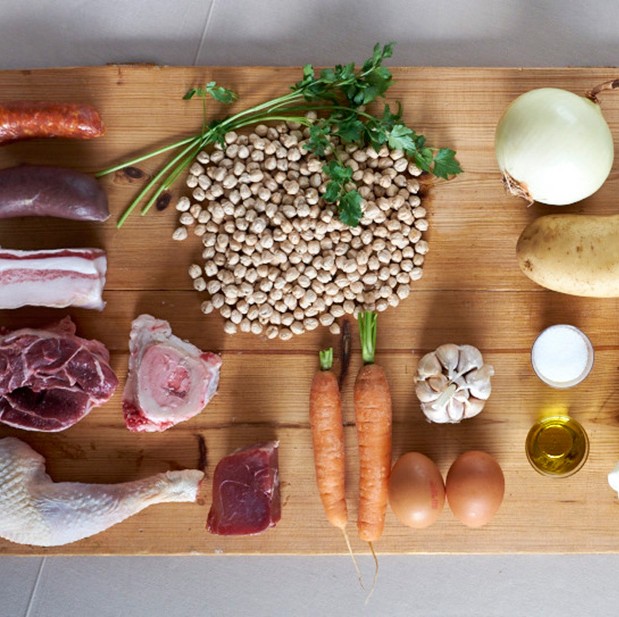
Ingredient substitutions for Madrid-Style Stew recipe
For the ingredients in a Madrid-style stew, some common substitutions and notes include:
- Chickpeas: Castilian chickpeas are the traditional choice, but any variety can be used. Soaking the chickpeas overnight with a handful of coarse salt helps prevent them from falling apart during cooking.
- Meats: A combination of beef, pork, ham hock, and chorizo is typical, but the exact meats can vary depending on personal preference.
- Vegetables: Carrots, potatoes, and cabbage are typical additions, but other root vegetables or greens can be added as desired.
- Saffron: Used for flavor and color, it can be omitted if unavailable or for a milder flavor.
- Noodles: Fine noodles are used for the soup, but other pasta shapes or rice can be used as a substitute.
- Fat: To reduce the amount of fat in the stew, the chorizo and blood sausage can be cooked separately and added to the stew just before serving.
Directions of Madrid-Style Stew recipe
The night before cooking the Madrid “cocido” stew, soak good Castilian chickpeas in water.
Trick: Add a handful of coarse salt to the water to prevent the chickpeas from getting stuck during cooking.
Start by boiling the meats, ham bone, and bones in cold water. Key: Throughout the cooking process, remove any foam that forms with a skimmer. Also, add water as it evaporates so that the stew does not become dry.
Keep the heat for the stew at medium continuously. When the water begins to boil, add the drained and washed chickpeas. The chickpeas will take between two and three hours to become tender if cooked over low heat, or 20 minutes in a pressure cooker. Recommendation: Put the chickpeas in a mesh bag to make it easier to remove them at the end of cooking and serve the stew in the traditional three courses.
In a separate pot, cook the cabbage. In another pot, cook the chorizo and blood sausage to prevent the broth from becoming greasy. When the stew is almost done, add the peeled potatoes and carrots to the Madrid “cocido” stew pot.
When finished, remove the meats and serve on a platter, along with the chorizo and blood sausage. Fry the cabbage and serve with the chickpeas, potatoes, and carrots on a platter. To make the soup, strain the broth and add noodles when the broth begins to boil. Thin noodles only take two or three minutes to cook.
Tips for Madrid-Style Stew recipe
Here are some tips for a good preparation of Madrid’s “cocido” stew:
- Soak the chickpeas overnight to soften them and reduce cooking time.
- Use high-quality broth for added flavor.
- Sear the meats before adding them to the stew to enhance their flavor.
- Add the vegetables in order of cooking time, starting with the ones that take the longest to cook.
- Simmer the stew gently to prevent the ingredients from breaking apart.
- Taste and adjust the seasoning as needed, adding more salt, pepper, paprika, or bay leaves as desired.
- Serve with crusty bread to soak up the flavorful broth.
- Let the stew rest for a few minutes before serving to allow the flavors to meld.
Suggestions for serving
Here are some suggestions for serving Madrid’s “cocido” stew:
- Serve in bowls, with a ladle for the broth and a separate dish for the meats and vegetables.
- Offer additional condiments such as hot sauce, diced onions, or lemon wedges for added flavor.
- Serve with crusty bread for dipping in the broth.
- Pair with a red or white Spanish wine, such as a Rioja or Rueda.
- For a traditional presentation, serve the dish in two courses, starting with the broth and vegetables and finishing with the meats.
- Offer a green salad or a tomato and cucumber salad as a refreshing side dish.
- Finish the meal with a dessert such as flan or natillas, or a strong coffee.
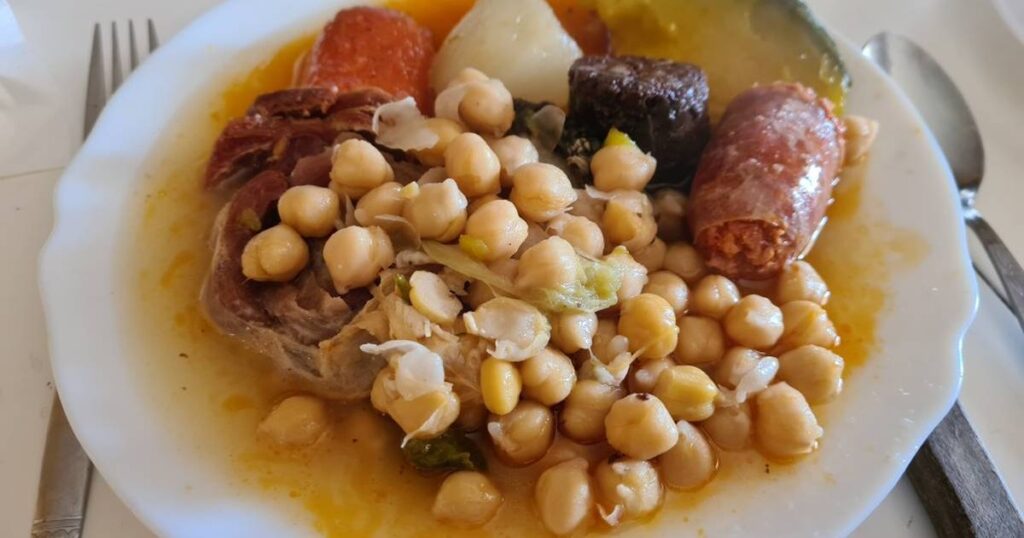
FAQs
Here are some possible frequently asked questions about preparing Madrid’s “cocido” stew:
- What kind of chickpeas should I use? Dried chickpeas work best for this dish, as they have a firmer texture and hold up better during cooking.
- Can I use canned chickpeas? Yes, you can use canned chickpeas, but keep in mind that the texture will be softer and the cooking time will be shorter.
- What kind of broth should I use? Chicken or beef broth both work well in this dish, and you can use either homemade or store-bought.
- Can I use other meats besides chorizo and ham? Yes, some recipes call for including a piece of flank steak, chicken, or pork.
- How long should I simmer the stew? Simmer the stew for 2 hours or until the chickpeas are soft and the vegetables are tender.
- Can I make this dish ahead of time? Yes, the flavors of the stew actually improve the next day, so it’s a great option for meal prep or entertaining.
- Can I freeze the stew? Yes, the stew can be frozen for up to 3 months. Thaw in the refrigerator overnight before reheating.

